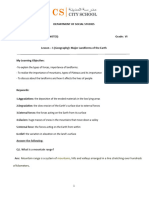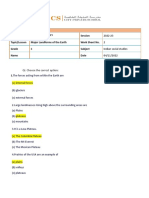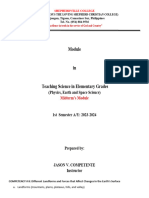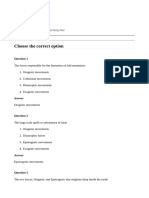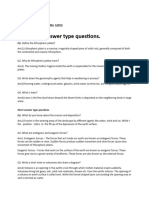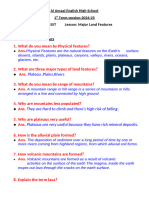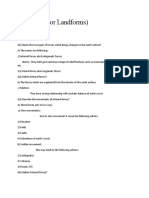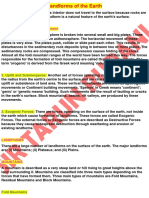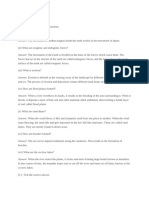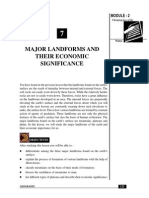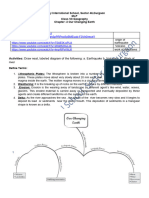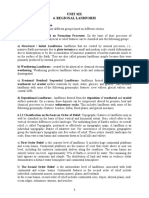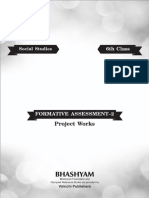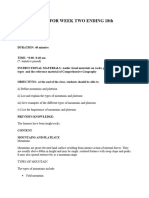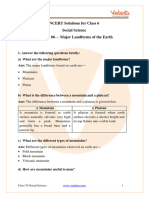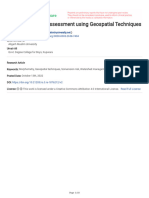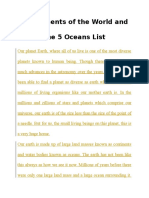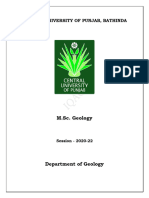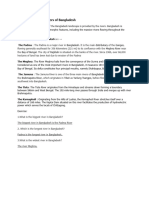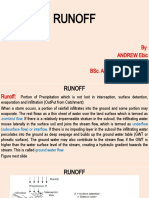Land New Notes FNL
Land New Notes FNL
Uploaded by
Mohammed ZayamCopyright:
Available Formats
Land New Notes FNL
Land New Notes FNL
Uploaded by
Mohammed ZayamOriginal Description:
Original Title
Copyright
Available Formats
Share this document
Did you find this document useful?
Is this content inappropriate?
Copyright:
Available Formats
Land New Notes FNL
Land New Notes FNL
Uploaded by
Mohammed ZayamCopyright:
Available Formats
Details
Category Notes Session 2022-23
Topic/Lesson Major Landforms of the Earth Work Sheet No. 2
Grade 6 Subject Indian social studies
Name Date 04/11/2022
My Learning Objective:
-To explain the types of forces, importance of landforms.
-To realize the importance of mountains, types of Plateaus and its importance
-To discuss about the landforms and how it affects the lives of people
Keywords:
1.Aggradations: the deposition of the eroded materials in
the low lying areas
2.Degradation: the slow erosion of the Earth’s surface due
to external forces
3.External forces: the forces acting on the Earth from its
surface
4.Glaciers: huge masses of snow in the mountains that
move down a valley
5.Internal force: the forces acting on the
Earth from within
6 .Landforms: the variation in elevation on the land’s
surface
4. Answer the following:
Q1. What is a mountain range?
Ans: Mountain range is a system of mountains, hills and valleys arranged in a line stretching over hundreds
of kilometers.
Q2. Define Volcanic mountain.
Ans: Volcanic mountains are formed when hot magma accumulates around the vent forming
cone-shaped mountains.
Q3. What is Lava Plateau?
Ans: Lava plateaus are formed by the fissures when volcanoes erupt. They cover a large area. The
Malwa Plateau and Columbia Plateau are examples of lava plateau
Q4. Classify mountains on the basis of origin. How are mountains different from plateaus?
Ans: On the basis of origin, mountains are of three types
: Fold mountains are formed due to collision between plates deep beneath the Earth's surface. Young fold
mountains like the Himalayas, Andes and Rockies have been formed geologically recently, while old fold
mountains are those which have been formed much earlier
(a) Fold mountains: They are formed by a collision between plates deep beneath the Earth's surface.
(b) Block mountains: These are formed when two tectonic plates move away from each other
causing cracks on the surface of the Earth. When cracks occur, the strip of land or the block of land
between them may be raised resulting in the formation of block mountains.
(c) Volcanic mountains: These are formed due to volcanic activities during a volcanic eruption.
Mountains: are huge masses of land rising above the surrounding area. It is conical in shape with a peak at
the top and the base at the bottom is wide. They have steep slopes which run from the peak to the base.
Plateaus: have a large summit area which rises above the surrounding area. It is a tableland. They may
have one or more sides with steep slopes.
Q5. How are plains formed?
Ans: Plains are formed as a result of the internal and external forces of the Earth. They are formed by the
rivers and their tributaries. The eroded material carried by the rivers gets deposited in low lying valleys in
the form of sediments containing stones, sand and silt. It takes a long period to form plains.
Q6. What are the continental plateaus?
Ans: Continental plateaus extend over a large area and rise abruptly from the bordering
lowland or the sea. The plateaus of South Africa, West Australia, and Greenland
, Q7. How do the landforms affect the life of human beings?
Ans: Humans live on different kinds of landforms in different ways. People living in mountain areas lead a
hard life. In the plains, the living conditions are better. Every landscape has a different pattern of living.
Sometimes, natural calamities like earthquakes, volcanic eruption, storms and floods cause widespread
destruction. However, through awareness we can reduce the loss of life and property during such
calamities.
HOTS:
Q1. Why are plains densely populated?
Ans: Plains are densely populated because:
(a) the living conditions are better than in the mountains and Plateaus.
(b) the soil is very fertile and suitable for the cultivation of various Crops.
(c) It is easy to construct buildings, roads, and lay railway lines in the plains.
It is very useful area for human habitation as the climatic conditions are favorable.
Q2 . Why is the life in mountain regions difficult?
(d) Ans: Life in the mountain regions is difficult because of the harsh climatic conditions and limited
availability of land for cultivation due to the steep slopes. On the steep slopes, it is difficult to
construct buildings, roads and lay railway lines in the mountains
.
Worksheet
Prepared By: Ms. Farha Naaz
Page 1 of 6
You might also like
- Geography SBADocument34 pagesGeography SBAloriann brownNo ratings yet
- (Notes) Grade 6 (Geo) L-6 Major Landforms of The EarthDocument6 pages(Notes) Grade 6 (Geo) L-6 Major Landforms of The EarthRXDestroyersNo ratings yet
- Jh EcampusUpload SubjectNote 9dcb8582-402c-4bd7-90fe-88cc7874979b LANDFORM of the EARTHDocument6 pagesJh EcampusUpload SubjectNote 9dcb8582-402c-4bd7-90fe-88cc7874979b LANDFORM of the EARTH24beautifullifeNo ratings yet
- Lesson 6 (Notes) Major Relief Feature of The EarthDocument4 pagesLesson 6 (Notes) Major Relief Feature of The Earthmohamedaahil12318No ratings yet
- Geog CH 6 Major Landforms of The EarthDocument5 pagesGeog CH 6 Major Landforms of The EarthMRUNAL PATILNo ratings yet
- GEOGRAPHY-L3-The Changing Face of The EarthDocument3 pagesGEOGRAPHY-L3-The Changing Face of The EarthRohit0% (1)
- Landforms of The Earth Class 9 - Total Geography Morning Star Short Answer QuestionsDocument74 pagesLandforms of The Earth Class 9 - Total Geography Morning Star Short Answer Questionsmithi 1203No ratings yet
- Pt2 Landforms of The Earth AnswerkeyDocument5 pagesPt2 Landforms of The Earth AnswerkeyMohammed ZayamNo ratings yet
- Competency 8 Ay 2023 2024Document14 pagesCompetency 8 Ay 2023 2024chaibalinNo ratings yet
- Class - Vi Lesson - 6: Fold MountainsDocument4 pagesClass - Vi Lesson - 6: Fold MountainsAvneet SinghNo ratings yet
- Grade 6 - Geography - Landforms of The Earth - Question Bank Answer KeyDocument3 pagesGrade 6 - Geography - Landforms of The Earth - Question Bank Answer KeyPrabha T100% (1)
- Untitled 1dffDocument13 pagesUntitled 1dffanishvb11No ratings yet
- Science-Grade 10: Plate Tectonics Mountain Ranges of The WorldDocument16 pagesScience-Grade 10: Plate Tectonics Mountain Ranges of The Worldmyra neri100% (4)
- Environmental ScienceDocument8 pagesEnvironmental SciencesaviiNo ratings yet
- Major Landforms of The Earth Lesson6 NotesDocument5 pagesMajor Landforms of The Earth Lesson6 NotesamalNo ratings yet
- 2ND Term S1 GeographyDocument20 pages2ND Term S1 Geographydavidmadu82No ratings yet
- SSE 102 Module 5Document5 pagesSSE 102 Module 5RubyBarnacheaNo ratings yet
- Geography 6 KeybookDocument14 pagesGeography 6 KeybookWasif ZofishanNo ratings yet
- Very Short Answer Type Questions.: CH-3 Our Changing EarthDocument5 pagesVery Short Answer Type Questions.: CH-3 Our Changing Earthiaaravyadav20No ratings yet
- Study Guide For Module No. 5Document5 pagesStudy Guide For Module No. 5Maia GabrielaNo ratings yet
- LP-G10 Processes and Types of BoundariesDocument4 pagesLP-G10 Processes and Types of BoundariesJohnie Rey VillaruzNo ratings yet
- AK CN Grade+6 Social+Science Chapter+17 Class+1 v02Document5 pagesAK CN Grade+6 Social+Science Chapter+17 Class+1 v02mdhilipanandNo ratings yet
- Geography SS One NotesDocument63 pagesGeography SS One NotestundeezeugborNo ratings yet
- Ss1 2nd Term Geography E-NotesDocument55 pagesSs1 2nd Term Geography E-Notespalmer okiemuteNo ratings yet
- Proper QnADocument2 pagesProper QnAhamdaniqbal380No ratings yet
- Nikki Faults and MountainDocument3 pagesNikki Faults and MountainHyung BaeNo ratings yet
- CH 4Document12 pagesCH 4Xain RanaNo ratings yet
- Earthquake ZonesDocument5 pagesEarthquake ZonesHiShaneNo ratings yet
- Chapter 5 Landforms of The EarthDocument4 pagesChapter 5 Landforms of The Earthaymantahmid913No ratings yet
- Nikki Faults and MountainDocument8 pagesNikki Faults and MountainHyung BaeNo ratings yet
- Agent of Change On Earth: Unit:1Document4 pagesAgent of Change On Earth: Unit:1Shabbir AhmedNo ratings yet
- Landforms of The EarthDocument4 pagesLandforms of The EarthRatul RanjanNo ratings yet
- Class 6 geography chap 6Document5 pagesClass 6 geography chap 6ayushuma1No ratings yet
- Class-VII SST Notes-4 Our Changing EarthDocument4 pagesClass-VII SST Notes-4 Our Changing Earthdivyaansh.aroraNo ratings yet
- Geo 3Document4 pagesGeo 3Prem KukrejaNo ratings yet
- Landforms of The EarthDocument4 pagesLandforms of The EarthSrinjon SahaNo ratings yet
- Science 10 ModuleDocument21 pagesScience 10 ModuleGregorio Rizaldy100% (1)
- Assignment 1 Geo 205 Faculty: SZR Submitted by:MD Shariful Islam ID:1530429030 Section:9 Datej:21 July 2020Document8 pagesAssignment 1 Geo 205 Faculty: SZR Submitted by:MD Shariful Islam ID:1530429030 Section:9 Datej:21 July 2020MSI SajeebNo ratings yet
- CH 3 Our Changing EarthDocument5 pagesCH 3 Our Changing Earthaggarwalkavish123No ratings yet
- Class 7 - Changing Our EarthDocument5 pagesClass 7 - Changing Our EarthChahek KalraNo ratings yet
- Major Landforms and Their Economic Significance: Module - 2Document15 pagesMajor Landforms and Their Economic Significance: Module - 2Kamal Singh RajputNo ratings yet
- Landforms on Earth.9th Geo.projectDocument15 pagesLandforms on Earth.9th Geo.projectsaeekoli2007No ratings yet
- Unit 2 English Contents. Relief and LandformsDocument11 pagesUnit 2 English Contents. Relief and LandformsJulia Casanova GonzalezNo ratings yet
- Module 12 Inside The Solid EarthDocument43 pagesModule 12 Inside The Solid EarthKaye Celyne C AmaproNo ratings yet
- CHAPTER 2 LandformsDocument6 pagesCHAPTER 2 LandformsR SatishNo ratings yet
- VII Our Changing Earth - 3Document3 pagesVII Our Changing Earth - 3gazalyadavNo ratings yet
- East West Model School: Q1. What Are Plains?Document3 pagesEast West Model School: Q1. What Are Plains?Prob TitanNo ratings yet
- MLP-Chap-3-Our Changing Earth1Document5 pagesMLP-Chap-3-Our Changing Earth1Divyanshi BansalNo ratings yet
- Geography_Notes_book_g12Document29 pagesGeography_Notes_book_g12jofetolera154No ratings yet
- Samplepractice Exam 2 March 2014 Questions and AnswersDocument57 pagesSamplepractice Exam 2 March 2014 Questions and AnswersjilnaNo ratings yet
- ss3 Lesson Plan and NoteDocument16 pagesss3 Lesson Plan and NoteGerald DogbeyNo ratings yet
- Geo PDFDocument13 pagesGeo PDFTezera Mark TmhNo ratings yet
- Activity SheetDocument7 pagesActivity SheetJofel CañadaNo ratings yet
- Aw Our Changing Earth-Edited PDFDocument15 pagesAw Our Changing Earth-Edited PDFronel.jnmsNo ratings yet
- Geography Theme 1 - Plate TectonicsDocument11 pagesGeography Theme 1 - Plate TectonicsShaun Tian JunNo ratings yet
- 29e16833 9e17 4457 A903 37dbe90e35f2 7.social6thfa2Document7 pages29e16833 9e17 4457 A903 37dbe90e35f2 7.social6thfa2maniakki712No ratings yet
- Mountains and PlateauxDocument7 pagesMountains and PlateauxRafiu GiwaNo ratings yet
- NCERT Solutions For Class 6 Social Chapter 6 - Major Landforms of The Earth - .Document4 pagesNCERT Solutions For Class 6 Social Chapter 6 - Major Landforms of The Earth - .Sai IshanNo ratings yet
- Chapter 3 Our Changing EarthDocument5 pagesChapter 3 Our Changing Earthshubhada okadeNo ratings yet
- Major LandformDocument12 pagesMajor LandformMohd. JavedNo ratings yet
- Kid’s Guide to Types of Landforms - Children's Science & NatureFrom EverandKid’s Guide to Types of Landforms - Children's Science & NatureNo ratings yet
- Unit 2 Endogenic Exogenic ProcessesDocument67 pagesUnit 2 Endogenic Exogenic Processeschristy janioNo ratings yet
- Soil Erosion Risk Assessment Using Geospatial TechDocument18 pagesSoil Erosion Risk Assessment Using Geospatial Techm85343279No ratings yet
- 7 Continents of The World and The 5 Oceans ListDocument42 pages7 Continents of The World and The 5 Oceans ListKabeer GolechhaNo ratings yet
- Waterbodies in DelhiDocument30 pagesWaterbodies in Delhishreya jaiswalNo ratings yet
- GROUP 1 The Wonders of Bukidnon PlateauDocument9 pagesGROUP 1 The Wonders of Bukidnon PlateaujnnpctngNo ratings yet
- Ology 20Document54 pagesOlogy 20Shachin ShuklaNo ratings yet
- Soil Texture Soil ActivityDocument2 pagesSoil Texture Soil Activityapi-475616324No ratings yet
- Assessment of The Impact of Urbanization On GeoenvironmentalDocument10 pagesAssessment of The Impact of Urbanization On GeoenvironmentalSopheak KhimNo ratings yet
- Lab 8 Surface WaterDocument10 pagesLab 8 Surface WaterGil GameshNo ratings yet
- 2016 Reynard - Current Research On GeomorphositeDocument3 pages2016 Reynard - Current Research On Geomorphositesap handayaniNo ratings yet
- 2016 FlashfloodgironaDocument20 pages2016 FlashfloodgironaQuique Ortiz AndresNo ratings yet
- Name of GlacierDocument4 pagesName of Glacierrazaaziz422No ratings yet
- Prelims CAMP Schedule and Detailed Syllabus-1 PDFDocument17 pagesPrelims CAMP Schedule and Detailed Syllabus-1 PDFsivank yoNo ratings yet
- Places and Landscapes in The Changing WorldDocument5 pagesPlaces and Landscapes in The Changing WorldRaffy Jade Salazar100% (1)
- FluvposterDocument1 pageFluvposterapi-314472601No ratings yet
- Geology For Engineers: The Geological Model, Prediction and PerformanceDocument132 pagesGeology For Engineers: The Geological Model, Prediction and PerformanceAnonymous ECNRVD0R100% (1)
- All About Me - Satyarup SiddhantaDocument15 pagesAll About Me - Satyarup Siddhantaapi-261873526No ratings yet
- Erosion and Deposition 2015-2016 v3Document58 pagesErosion and Deposition 2015-2016 v3api-263382165No ratings yet
- PreviewDocument26 pagesPreviewARSLAN SHAHIDNo ratings yet
- VenezuelaDocument7 pagesVenezuelaalexandrearagaoNo ratings yet
- Geological Survey of India: by Prabhas PandeDocument12 pagesGeological Survey of India: by Prabhas PandeShuja MehdiNo ratings yet
- Rivers of BangladeshDocument3 pagesRivers of BangladeshRanathunga ThennakoonNo ratings yet
- Quaternary Geology of The Fort Polk Area, SW Louisiana (2002)Document25 pagesQuaternary Geology of The Fort Polk Area, SW Louisiana (2002)etchplainNo ratings yet
- Trabajo FluidosDocument7 pagesTrabajo FluidosJaneth Lopez ContrerasNo ratings yet
- WTCPUA-Water Service Area Exhibit 1.20.15Document1 pageWTCPUA-Water Service Area Exhibit 1.20.15Anonymous Pb39klJNo ratings yet
- Chapter Test IIIDocument18 pagesChapter Test IIIEsmael KasilagNo ratings yet
- 17-Associate Degree in Geography - 1698052910Document37 pages17-Associate Degree in Geography - 1698052910ayannaeem36052No ratings yet
- Notes On Tours in Darjeeling and Sikkim (With Map) (IA Notesontoursinda00buch)Document54 pagesNotes On Tours in Darjeeling and Sikkim (With Map) (IA Notesontoursinda00buch)sansadNo ratings yet
- War 2103 RunoffDocument41 pagesWar 2103 RunoffEgana IsaacNo ratings yet

